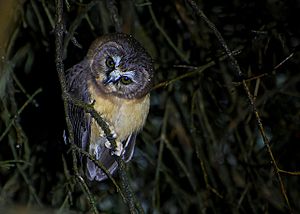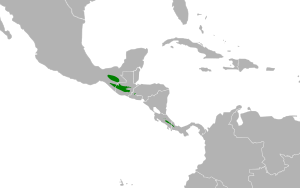Unspotted saw-whet owl facts for kids
Quick facts for kids Unspotted saw-whet owl |
|
|---|---|
 |
|
| Conservation status | |
| Scientific classification | |
| Genus: |
Aegolius
|
| Species: |
ridgwayi
|
 |
|
The unspotted saw-whet owl (Aegolius ridgwayi) is a small owl. It is found in countries like Costa Rica, El Salvador, Guatemala, Mexico, and Panama. This owl is known for its plain look, unlike some other owls with spots or stripes.
Contents
What Does the Unspotted Saw-Whet Owl Look Like?
This owl is quite small, usually about 18 to 21.5 centimeters (7 to 8.5 inches) long. It weighs around 80 to 90 grams (about 3 ounces), which is like a small apple.
Its back, throat, and upper chest are a plain brown color. Its lower chest and belly are a cinnamon-buff color, which is a light reddish-brown. The tail is a darker brown, and its wings are a grayish-brown.
The owl's face is brown with a thin white border. The area around its eyes and chin is whitish. It has bright yellow eyes that stand out.
Where Does the Unspotted Saw-Whet Owl Live?
This owl lives in humid, cool mountain forests. You can find it in places like oak forests, cloud forests (where clouds often cover the trees), and pine-oak forests.
It usually stays high up in the forest trees. However, it can also be seen in more open areas with a few scattered trees, especially near the edge of a forest.
The owl lives at different heights depending on the country. In the northern parts of its range, it lives between 1,700 and 3,000 meters (about 5,600 to 9,800 feet) above sea level. In Costa Rica, it's found between 2,200 and 2,900 meters (7,200 to 9,500 feet). In Panama, it can be found even higher, from 2,100 to 3,500 meters (6,900 to 11,500 feet).
How Does the Unspotted Saw-Whet Owl Behave?
The unspotted saw-whet owl is a nocturnal animal, meaning it is active at night. During the day, it rests. It usually lives alone, except when it's time to find a mate and raise a family. Scientists believe these owls protect their own areas, called territories.
When it flies, its movements are described as "fluttery" and "agile," with quick wingbeats.
Movement and Migration
This owl does not migrate. It stays in the same area all year round.
What Does the Unspotted Saw-Whet Owl Eat?
Scientists don't know all the details about what this owl eats. However, they believe its main food source is small mammals. This includes animals like shrews and rodents (like mice). It is also thought to eat small birds and bats.
Reproduction and Life Cycle
Not much is known about how the unspotted saw-whet owl raises its young. It seems their breeding season is between March and July.
These owls make their nests in holes in trees. These holes can be natural, or they might have been made by woodpeckers. It's thought that the female owl lays about five or six eggs.
What Sounds Does the Unspotted Saw-Whet Owl Make?
The male unspotted saw-whet owl has a special call to mark its territory. It sounds like a whistled "hoo hoo hoo…" repeated about 10 times over three to five seconds.
Female owls make a high, slightly hissing "ssirr" sound. Both male and female owls can also make a surprisingly loud shriek and a shrill, short "chipper" sound.
Interestingly, the call of some tree frogs (from the genus Anotheca) sounds very similar to the owl's song. This can sometimes make it hard to tell them apart!
Is the Unspotted Saw-Whet Owl in Danger?
The IUCN (International Union for Conservation of Nature) has listed the unspotted saw-whet owl as a species of "Least Concern" since 2004. This means they are not currently worried about it becoming extinct. The total number of these owls is not known, but it is believed to be stable.
However, there are some challenges. The owl's forest home is mostly undisturbed only in the highest mountains. In lower areas, forests are being cut down for wood, farming, and raising animals. In Mexico, conservation groups list this owl as being in danger of extinction in that country.
See also
 In Spanish: Mochuelo moreno para niños
In Spanish: Mochuelo moreno para niños


